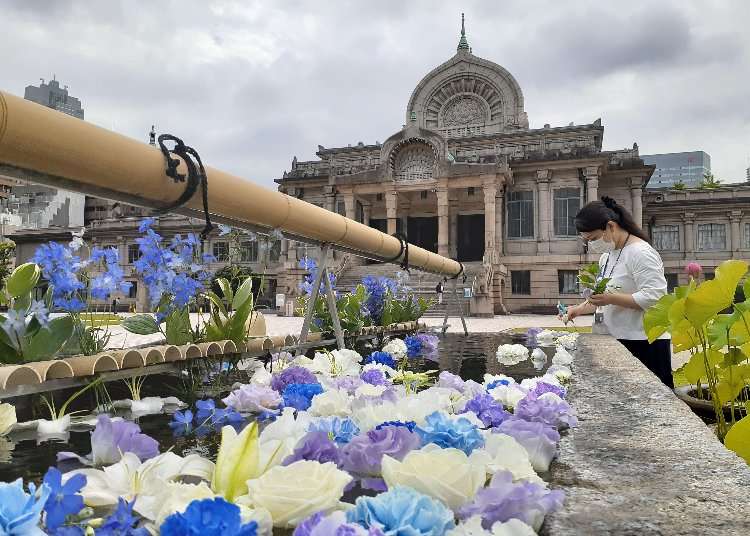
What Is 'Hanachozu' - Japan's New Way To Heal At Temples And Shrines Amid The COVID-19 Pandemic?
- Written by: Miyu Shimada
Have you ever heard of hanachozu? Found at the entrances of many temples and shrines throughout Japan are chozus - large water basins with wooden dippers used to purify oneself before prayer.
Many shrines in Japan are transforming their water basins into beautiful floral art. Known as Hanachozu, these flower arrangements use fresh, colorful, seasonal flower heads. And across Japan, they have become very popular in the wake of Covid-19.
Here we will introduce some background information on the hanachozu as well as soothing spots that you can visit in the Tokyo area perfect for taking photos. What’s more, we’ve also included a how-to on making a mini hanachozu at home!
What is Hanachozu?
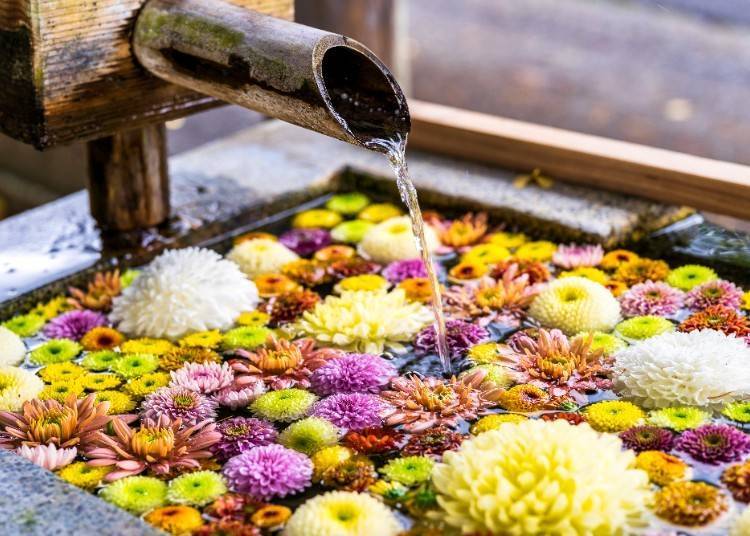
Hanachozu was initially used as a way to purify oneself by using the dew on flowers and plants instead of water.*
In many of the temples and shrines throughout Japan, the practice of purifying your hands and mouth before prayer is called temizu or chozu.
Therefore, it’s fairly common to see water flowing from a bamboo pipe or a bronze statue of a dragon at the entrances of temples and shrines.
This is where the act of temizu is performed. For this reason, the Japanese name for these fountains is either temizusha (house of temizu) or chozusha (house of chozu).
Also, the wooden dippers used to carry the water are called temizubachi (dipper or bowl for temizu).
(*Some of the views or practices regarding hanachozu may differ due to the beliefs at certain temples and shrines.)
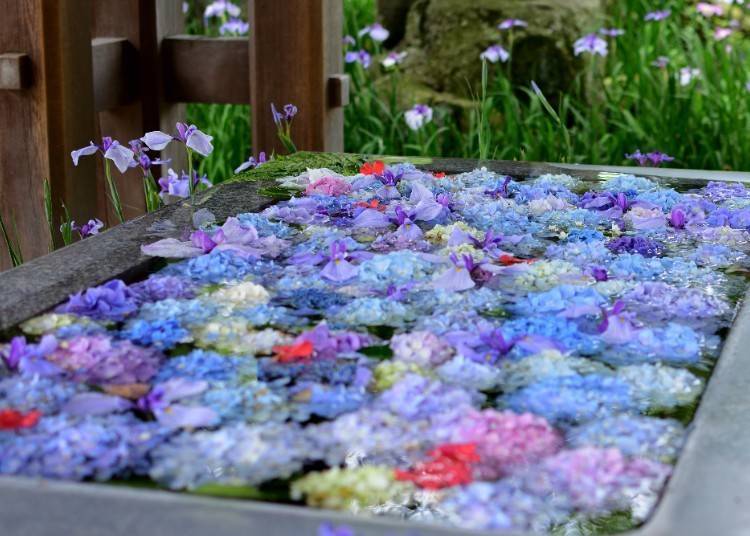
However, the present-day understanding of hanachozu is slightly different. Hanachozu now refers to flowers that float on the surface of chozus (basins or dippers). This is said to have originated from Kyoto’s Yanagidani Kannon (Yokoku-ji Temple).
Yokoku-ji Temple is historically known for being a temple of healing. Here, many people suffering from illness or disease visit to pray for better health. Additionally, it’s also known for its hydrangeas in early summer and foliage in the fall.
In 2015, the temple decorated its many chozus with fresh flowers. This display became a huge hit on Japanese social media.
New Hanachozu Art: Popularized During Covid-19!
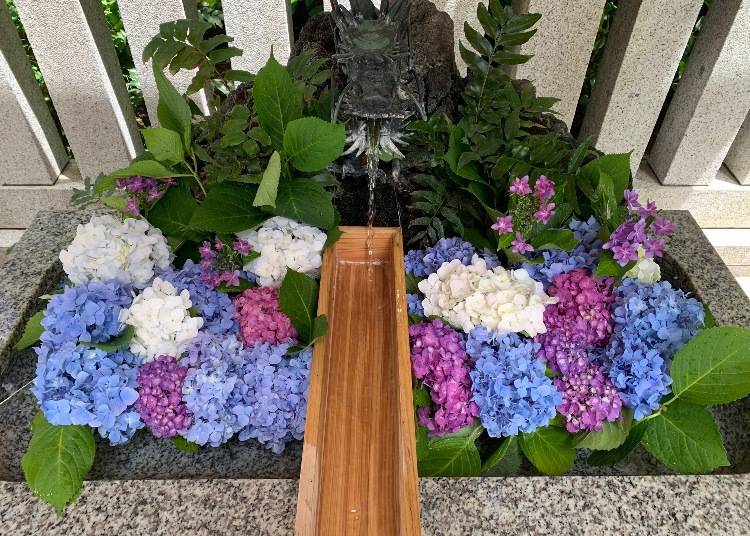
The new type of hanachozu became increasingly popular during Covid-19.
In order to slow the spread of the virus, many temples and shrines had to stop offering the usage of chozu to the general public. Because of this, temples and shrines throughout Japan took the opportunity to decorate their basins and dippers with flowers.
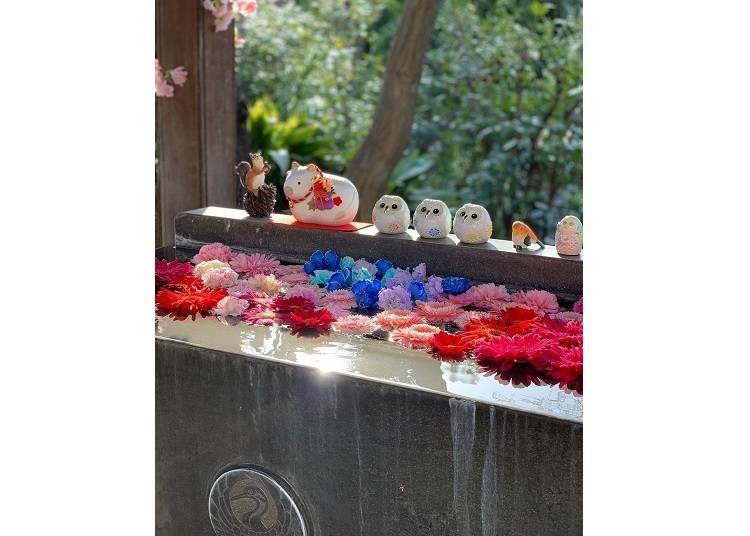
All temples and shrines have their own reason for implementing the new type of hanachozu. One of them is that the spread of Covid-19 has caused a dramatic decrease in the number of visitors.
As a way to attract more people, temples and shrines began to use flowers that would be otherwise disposed of to decorate their grounds.
In addition to the hope that hanachozu displays would bring its visitors some peace during a difficult time, they were arranged with the hopes that the spread of Covid-19 would soon stop.
These arrangements were quickly shared on many social media platforms and have soothed the hearts of many ever since.
Hanachozu in the Tokyo Area: Enjoy a New Display Each Season
You can even find hanachozu at famous temples and shrines in the suburbs! We will introduce spots that you can get to easily from central Tokyo.
① Horin-ji Temple
This temple is known for its many posts of colorful hanachozu on its official Instagram account. Calling themselves the committee for hanachozu promotion, they showcase many different displays throughout the year.
Furthermore, their famous and colorful goshuin, large stamps handwritten by monks, are a huge hit on social media. Horin-ji also offers sutra-copying workshops and yoga classes, so it’s super easy to stop by!
Being very open-minded and modern, the temple even has its own YouTube channel operated by the head priest.
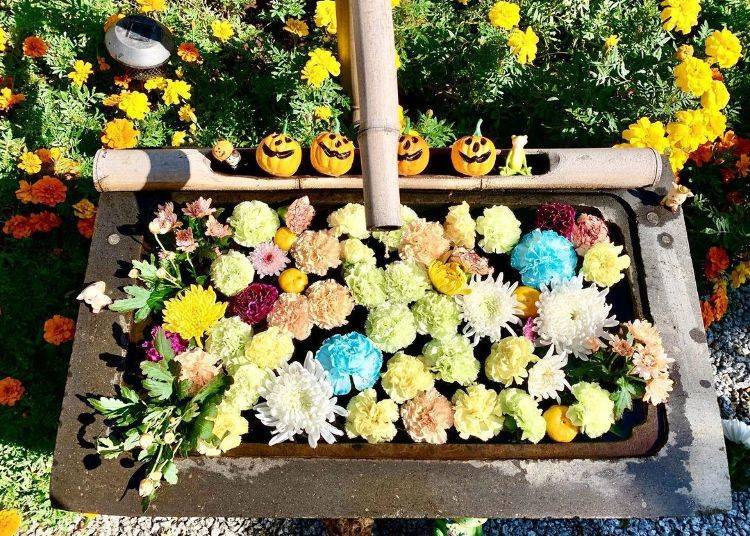
-
Horin-ji Temple法輪寺
- Address 1 Chome-1-15 Nishiwaseda Shinjuku City, Tokyo 169-0051
- Phone Number 03-3203-5410
② Nogi Shrine
This shrine was made to honor Nogi Maruseke, a soldier during the Meiji era that led Japan to victory in the Russo-Japanese War and his wife.
Because it’s covered in verdant greenery, Nogi Shrine acts as an oasis in the city. Its refined appearance is also one of its characteristics. From 2020, it began to decorate its grounds with hanachozu. Irregular displays are held mainly in the summer.
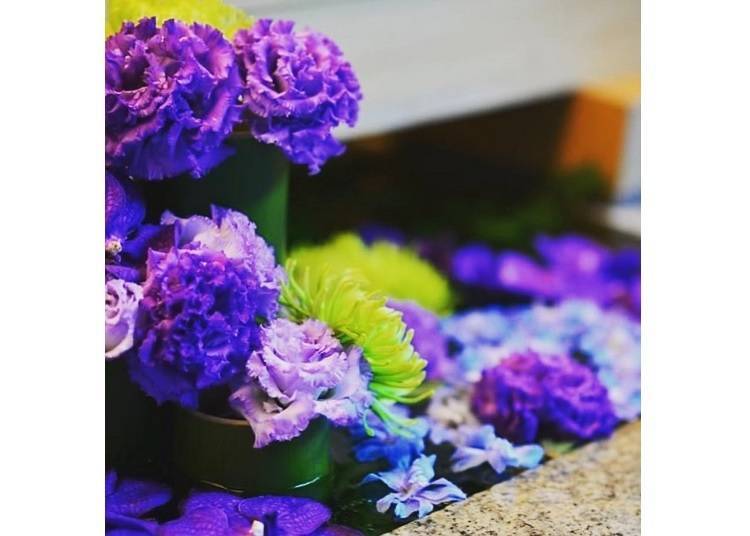
-

-
Address
8-11-27, Akasaka, Minato-ku, Tokyo, 107-0052
View Map -
Nearest Station
Nogizaka Station (Tokyo Metro Chiyoda Line)
1 minute on foot
- Phone Number 03-3478-3001
-
Address
8-11-27, Akasaka, Minato-ku, Tokyo, 107-0052
③ Tsukiji Hongwan-ji Temple
The characteristic of this temple is its uniquely beautiful and extravagant architecture inspired by ancient Buddhist designs from India. Inside the open space are a cafe, a book shop, and accommodation. It’s the perfect place to enjoy as a little getaway.
Moreover, the temple is close to the Tsukiji outer market, making it a great spot for sightseeing. Hanachozu displays are held irregularly.
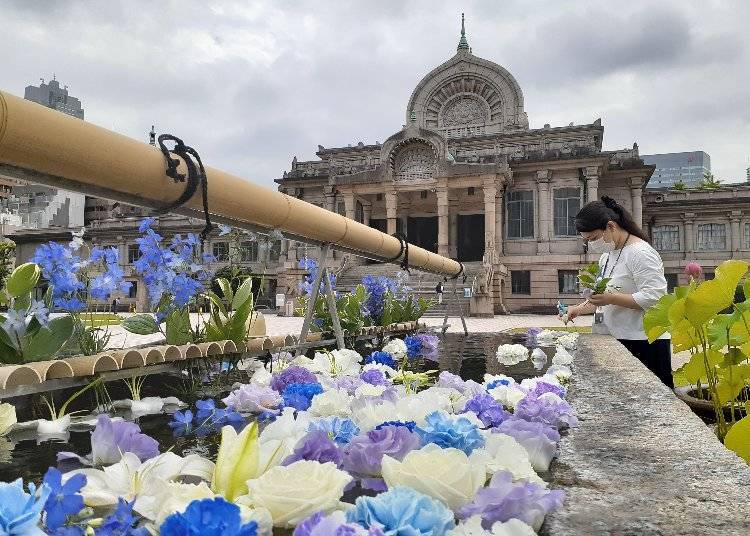
-

-
Address
3-15-1 Tsukiji, Chuo-ku, Tokyo, 104-8435
View Map -
Nearest Station
Tsukiji Station (Tokyo Metro Hibiya Line)
- Phone Number 0120-792-048
-
Address
3-15-1 Tsukiji, Chuo-ku, Tokyo, 104-8435
④ Shitaya Shrine
Located in Tokyo’s Ueno district, this shrine is the oldest Oinari-sama in the city. An Oinari-sama shrine is said to bring promises of a good crop to those who visit it.
Very fittingly, the Japanese kanji character for rice plant is used in its name. Here you can find irregular hanachozu displays as well as scheduled displays on the first of every month.
Flowers displayed monthly are made to complement the color of the shrine’s limited-edition goshuin.

-
Shitaya Shrine下谷神社
- Address 3 Chome-29-8 HigashiuenoTaito City, Tokyo 110-0015
- Phone Number 03-3831-1488
⑤ Fukutoku Shrine (Mebuki Inari)
Due to being located in a business district in Tokyo’s Nihonbashi, many business people visit Fukutoku Shrine. With its other name being Mebuki Inari, the shrine has a long history dating back to the year 860.
Also known for being a religious site for many samurai, it’s said that Tokugawa Ieyasu visited this sacred landmark during the Edo period (1603 – 1868).
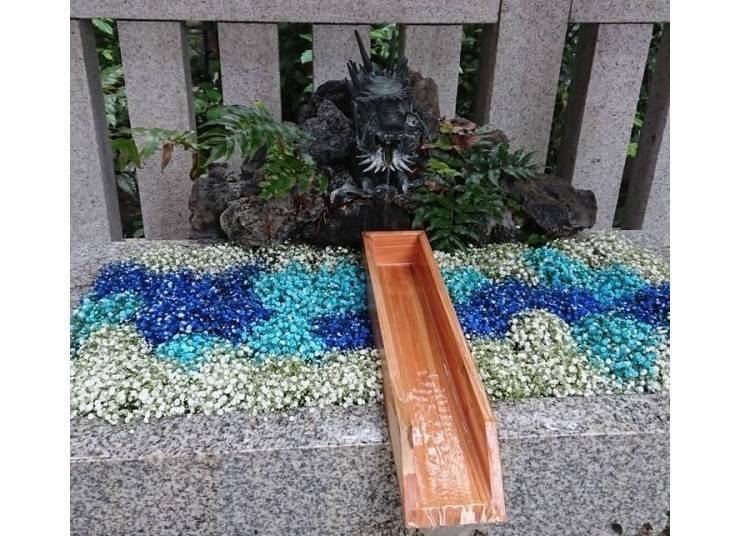
-
Fukutoku Shrine (Mebuki Inari)福徳神社/芽吹稲荷
- Address 2 Chome-4-14 Nihonbashimuromachi Chuo City, Tokyo 103-0022
- Phone Number 03-3276-3550
DIY: How to Make a Mini-Hanachuzo At Home
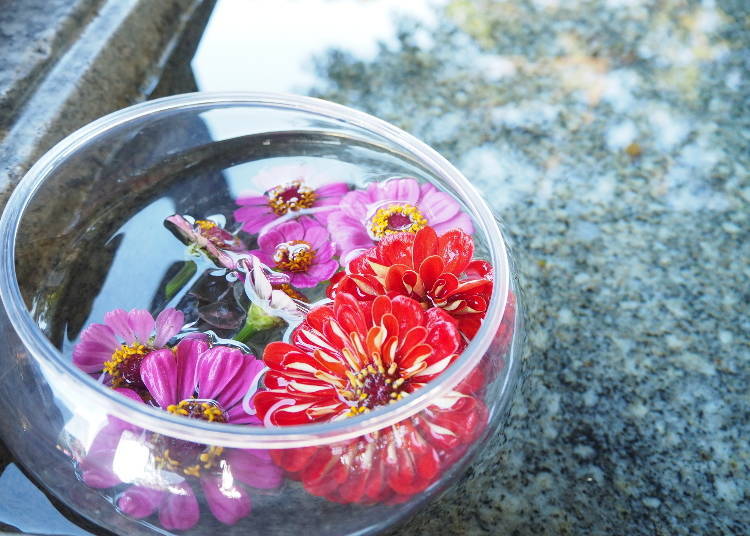
Hanachuzo can be easily made on your own. If you ever have the opportunity, please invite the peaceful atmosphere it brings into your home. Here we will introduce some tips on how to make a mini version.
It’s super easy! All you have to prepare are some cut flowers of your choice, scissors for the stems, a pot, and water.
Instructions on How to Make a Mini Hanachuzo
① Prepare a container
② Fill it with water
③ Because you only need the top part of the flower, cut the stem off with a pair of scissors.
④ Arrange the flowers so that they float how you like.
・Flower Recommendations
Brightly colored flowers with large blooming petals and flowers that appear round in shape when viewed from above are recommended. Examples: Gerbera daisies, sunflowers, chrysanthemums, roses, hydrangeas, etc.
・Recommended Pots
The best option is to use a round flower bowl or pot. However, you can also fill a bowl you already have at home with water.
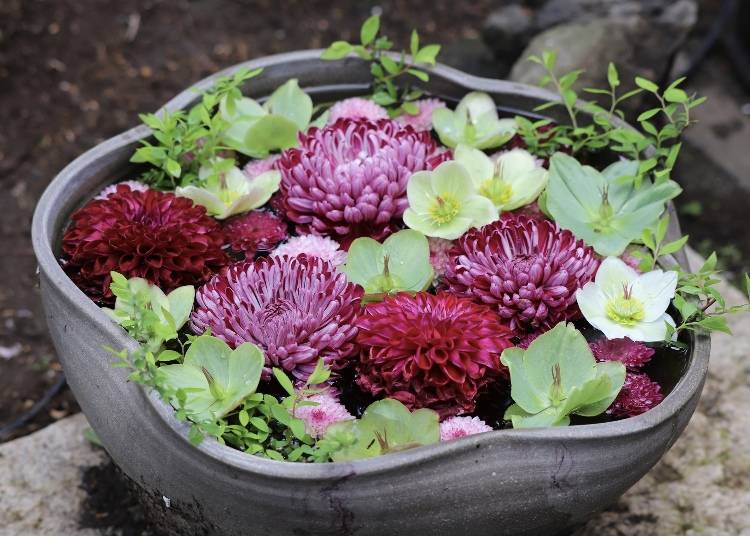
When it comes to hanachozu, there aren’t any rules on how to arrange the flowers. This freedom adds to its charm. Even already wilting flowers will come back to life once put in the water.
Soothe Your Body and Soul with Beautiful Hanachozu Art
Hanachozu is a form of traditional Japanese flower art. It began as a Japanese practice made with the intention of purifying the body and soul before prayer. As of late, it has turned into a display that brings peace to the people of the modern day.
Please visit some of the temples and shrines in Japan to take a look at the hanachozu displays. In addition to enjoying the unique arrangements at each temple and shrine, you can also enjoy the different displays of each season.
However, please keep in mind that flowers are a lifeform. The period in which these events are held is irregular. The display period also changes depending on the temple or shrine, so please be sure to check whether or not the event is being held in advance.
Miyu is a travel writer and tour conductor with over a decade of experience in developing educational content for working individuals. She has a passion for exploring new cultures and has visited more than 150 cities in around 50 countries. Her goal is to sample great food, experience nature, enjoy historical sites, and bathe in hot springs around the world. Miyu left her corporate job to pursue her passion for travel and now spends over 100 days a year abroad while working as a writer. She promotes the joy of travel, the beauty of Japan, and the diverse cultures of the world by traveling to different parts of Japan and collaborating with inbound tour operators and fellow travel writers.
- Area
- Category
*Prices and options mentioned are subject to change.
*Unless stated otherwise, all prices include tax.
Popular Tours & Activitiess
-

This Winter, Godzilla Takes Over Haneda Airport
by: Guest Contributor
-
Ad

Complete Guide to Ueno's National Museum of Nature and Science, the Perfect Place to Visit on Rainy Days or With Children
-

Jujutsu Kaisen Takes Over JR East With a Wrapped Shinkansen This Winter
by: Guest Contributor
-

Strawberries, Style, and Tokyo’s Coolest Neighborhood: Winter Afternoon Tea in Kichijoji
by: Guest Contributor
-

Japan’s Shinkansen Is About to Change Travel in an Unexpected Way
by: Guest Contributor
-
Ad

(Opening in Jan 2026) 'THE SUMO LIVE RESTAURANT HIRAKUZA GINZA TOKYO!' 5 Exciting Ways to Experience the World of Sumo!
Inspiration for Accommodations
-

Enjoy Mt. Fuji from the Comfort of Your Room! Recommended Ryokan with Mt. Fuji View
-

Stay Near the Cherry Blossoms! Hotels for Cherry Blossom Viewing in Tokyo
-

Family-Friendly Hotels with Free Shuttle to Disneyland: Convenient Access for a Magical Stay
-

Top Ranked Hakone Hotels with Mt. Fuji View: Enjoy Stunning Scenery from Your Private Space
-

Convenient Tokyo Hotels with Airport Shuttle: Ideal for Families and Heavy Luggage
-

Stunning Tokyo Tower View Hotels: Enjoy Spectacular Scenery from Your Private Space
-

Convenient Asakusa Hotels with Kitchens: Ideal for Extended Family Visits
-

Experience Luxury: Hakone's 10 Best Five-Star Accommodations
-

Enjoy Mt. Fuji Autumn Leaves! Top Hotels Near the Popular Autumn Leaves Corridor
-

Experience Hakone Fall Foliage from Your Room with Stunning Views
-

Healthcare in Japan for Tourists: What to Do When You Get Sick or Injured in Japan
-

Annual Survey Reveals Most Attractive Prefectures in Japan
-

6 Surprisingly Cheap Things in Japan
-

Savoring Spring at the Tokyo Nihonbashi Sakura Festival 2019 - Celebrating Sakura, Food, and Japanese Culture!
-

Japan’s Shinkansen Is About to Change Travel in an Unexpected Way
by: Guest Contributor
-

Experiencing Japanese Culture Firsthand: Authentic Tea Ceremony & Taking On Japanese Cooking!
- #best ramen tokyo
- #what to buy in ameyoko
- #what to bring to japan
- #new years in tokyo
- #best izakaya shinjuku
- #things to do tokyo
- #japanese nail trends
- #what to do in odaiba
- #onsen tattoo friendly tokyo
- #daiso
- #best sushi ginza
- #japanese convenience store snacks
- #best yakiniku shibuya
- #japanese fashion culture
- #best japanese soft drinks




















